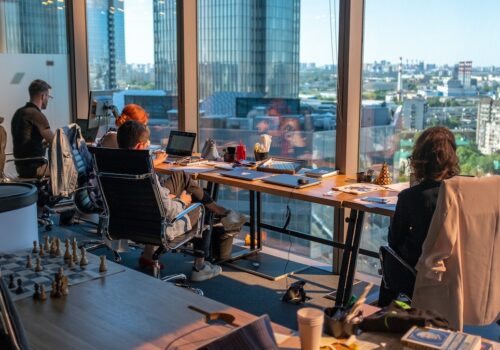Dear Jonathan,
It’s over. The love, the excitement. After four years of toiling, fighting, updating and arguing with my Learning Management System (LMS), it’s time for something new.
Even though it’s difficult, deep down I know moving on is the right thing to do. So I started a tendering process. Tinder for learning platforms, so to speak. And I experience so much joy again:
User-friendly systems. Easy flows. Social learning. All things that are necessary for sustainable employability. Things that motivate people to learn. Some of these platforms have gone through a lot already and have greatly matured. Others are still young, but have such a refreshing outlook. They think of things I never thought of before!
So why do I still think “never mind”? Why do I want to stick with my current LMS? It’s not working anymore. Not for me, but also not for them – our employees.
I acknowledge the possibilities are endless, but I can’t seem to make the final leap. What should I do?
I look forward to receiving your advice!
Thank you,
An anonymous L&D Manager
Dear anonymous L&D Manager,
Taking a different route than initially planned or anticipated isn’t easy. It has even been scientifically proven that it is more difficult for people to adjust course than to keep sailing through stormy weather. Our tendency to hold on to things even when they are no longer working is one of the favourite topics of many psychologists and economists. They call it the “sunk costs fallacy.” Allow me to give you some examples:
The sunk costs fallacy
The reason it’s so hard for us to deal with unforeseen changes, has something to do with the imbalance between loss and gain in our brain. Renowned psychologist Daniel Kahneman explains it as follows: any decision you make, always confronts you with a certain level of uncertainty about the future. To deal with this uncertainty, the human brain developed a system. One that helps you to – unconsciously and automatically – weigh potential losses. You may recognize this system as something that Darwin introduced a century ago with his survival of the fittest. In order to survive, we avoid risks at all costs.
Since our brains have been programmed this way for millennia, the prospect of loss has a much greater influence on our behaviour than the promise of gain. In fact, we have an innate aversion to loss. In economic terms, this phenomenon is referred to as the sunk cost fallacy. And there are many experiments and examples of how this affects our behaviour. I will highlight two of them here:
Example 1: Payment pain
One of the ways in which our innate aversion to loss plays out is described by Dan Ariely as “payment pain.” This type of pain comes up when you have to let go of something you have. What that is (or how much money) isn’t the most important factor at first.
To test this assumption, Ariely conducted an experiment with a chocolate candy stand. In the first scenario, passers-by could buy one Hershey’s Kiss chocolate for one penny or a Lindt truffle for fifteen cents. The majority chose the truffles. Considering the difference in quality and the normal costs of the truffles, this was also the best deal.
In the second scenario, he sold the same chocolates, but reduced the price by one cent for both of them. That meant the Kisses were now free and the truffles were fourteen cents. Now, most people chose the Kisses.
If people would be basing their decisions on mathematical logic, everyone would still buy a truffle. For the simple reason that the price difference was still the same. But people didn’t, because our brain doesn’t work that way. Instead, aversion to loss stepped into play. This mode is constantly on “standby” and tries to keep you from giving up more than you can afford.
Ariely speculates that we collect pointless items for free for this reason. (And why wouldn’t we? It didn’t cost us anything, right?) He also believes this is why we get tempted by dubious offers when a free toy or a free service comes along with it. It may also cause us to opt for an OK service that comes with free shipping, instead of the better quality fantastic service that does not offer this benefit.
Whenever something is offered for free, your aversion to loss remains inactive. And without perceived potential losses, you weigh the balance between loss and gain with much less detail.
Example 2: The past still keeps its power…
Hal Arkes and Catherine Blumer conducted an experiment in 1985 that demonstrated our prejudices against sunk costs in more detail. They asked the participants to assume that they had spent $100 on a ski trip. Soon after their imaginary booking, they discovered a better ski trip in a nicer place for $50. They were asked to imagine they also bought a ticket for this. But then the participants were asked to make a choice: the two trips happened to overlap, so they could only enjoy one of them. More than half chose to go for the $100 trip. Even though that more expensive one was anticipated to be less fun than the $50 trip, the loss seemed bigger. That’s the misconception of sunk costs. It ensures that you avoid the feeling of loss in the past. As a result, you do not choose the best experience for the future.
Perseverance or stubbornness?
Perseverance is valued in our society for it is a quality that shows your strength and determination. Most would probably consider it a beautiful human urge to persevere. To stay on course.
It appears only adult humans are blessed with this ability, as research has shown that children (and “simple” animals such as insects) are not susceptible to the sunk cost fallacy. They can only see immediate gain or loss. As adults, however, we are “blessed” with self-reflection and regret. You have the ability to predict a future scenario where your hard work was in vain, your losses are permanent and you have to accept that this will hurt. And that causes problems.
So do you stick with your LMS, or do you part ways? These 7 questions will help you decide
From your letter, I can tell that you already realized that you need an LMS or learning platform to become a learning organization. And after reading this article up until here, you know that us humans are only rational in our decision-making processes to a limited extent. But looking at your question, it seems you haven’t given up on the idea that the future can be different from the past (and better). That’s why I recommend asking yourself the following seven questions:
- Take a step back. If you had to buy the same LMS system again, would you do it? And why (not)?
- If your LMS ceases to exist spontaneously and you are contract-free as a result, would you buy the same system again? Why (not)?
- Do you miss out on opportunities because you are trying to avoid sunk costs? For example: are you giving up the opportunity to become a learning organization by sticking to your current LMS? And what does it cost you to keep things as they are?
- Can you still make an honest assessment of the benefits you gain from the current LMS when you compare it to the costs?
- Did you base your decision to opt for your current LMS at the time on the same knowledge that you have now? Can you state, with the knowledge you have today, that your current LMS does not meet the requirements of your organization?
- If you were to observe another in the same situation, what would you recommend to them? Stay stuck in the sunk costs or go for a new LMS or learning platform? We often advise others to report their sunk costs because we are not trying to justify our own behavior. We are talking about another.
- Would abandoning the sunk-cost ship be an example of a good decision? We’ve all made choices that didn’t work. These choices are also made within organizations. Knowing when to quit is the hallmark of good decision making.
Conclusion:
HR and L&D departments don’t have an easy task at hand today. To become an agile organization, you have to learn agile and that requires a lot of work. An LMS or learning platform can and will play a key role in this. So you will need a good one.
A good system provides you with great support, removes barriers to learning interventions, and gives your organization a detailed overview of the accumulated expertise and costs. A bad LMS or learning platform fails to ensure that your employees’ learning desires are realised and falls short where your organisation most needs it. But you may have already experienced that yourself.
I hope the article and tips above allow you to get more clarity. Still can’t figure it out? Don’t hesitate to contact me again. I will gladly assist you in making the right choice.
Sincerely,
Jonathan from Springest


